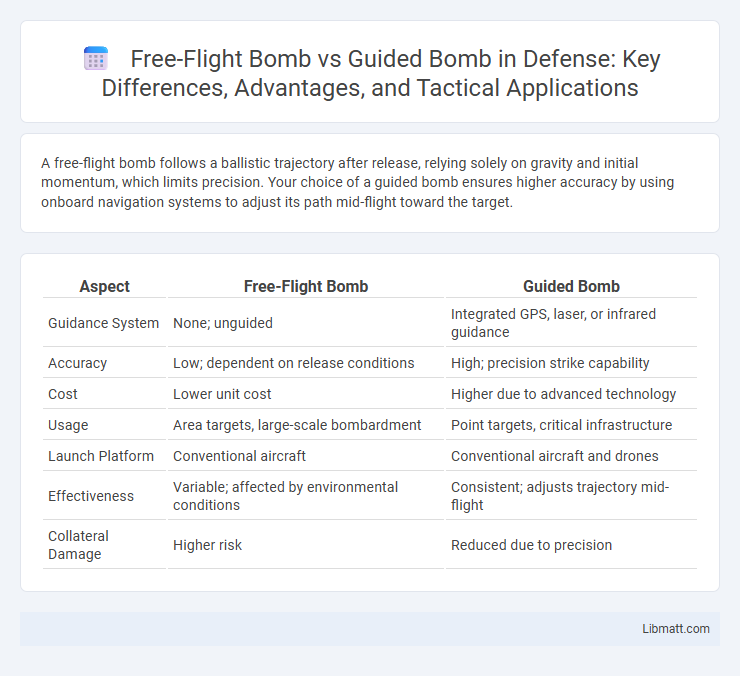A free-flight bomb follows a ballistic trajectory after release, relying solely on gravity and initial momentum, which limits precision. Your choice of a guided bomb ensures higher accuracy by using onboard navigation systems to adjust its path mid-flight toward the target.
Table of Comparison
| Aspect | Free-Flight Bomb | Guided Bomb |
|---|---|---|
| Guidance System | None; unguided | Integrated GPS, laser, or infrared guidance |
| Accuracy | Low; dependent on release conditions | High; precision strike capability |
| Cost | Lower unit cost | Higher due to advanced technology |
| Usage | Area targets, large-scale bombardment | Point targets, critical infrastructure |
| Launch Platform | Conventional aircraft | Conventional aircraft and drones |
| Effectiveness | Variable; affected by environmental conditions | Consistent; adjusts trajectory mid-flight |
| Collateral Damage | Higher risk | Reduced due to precision |
Introduction to Free-Flight Bombs and Guided Bombs
Free-flight bombs are unguided munitions that rely on ballistic trajectory after release, offering simplicity and lower cost but less accuracy compared to guided bombs. Guided bombs use advanced navigation systems such as GPS, laser, or infrared homing to precisely adjust their flight path toward the target, significantly improving strike accuracy and mission success. Your choice between these bombs depends on mission requirements, balancing cost, technology, and the need for precision.
Defining Free-Flight Bombs: Characteristics and Mechanisms
Free-flight bombs, also known as unguided bombs, rely solely on gravity and aerodynamic forces after release, lacking internal guidance systems to adjust their trajectory. These bombs are characterized by simple design, lower cost, and depend heavily on the launching aircraft's speed, altitude, and release angle for target accuracy. Your missions using free-flight bombs require precise deployment strategies to compensate for their inherent lack of post-release control compared to guided bombs.
Guided Bombs: Technology and Types
Guided bombs utilize advanced technologies such as GPS, laser guidance, and infrared homing to enhance targeting accuracy, significantly improving mission success rates compared to traditional free-flight bombs. Types of guided bombs include laser-guided bombs (LGBs), which rely on target-designating lasers, GPS-guided bombs like the JDAM (Joint Direct Attack Munition), and infrared-guided bombs that track heat signatures for precision strikes. These technologies enable precision engagement of moving or stationary targets with minimal collateral damage, optimizing modern warfare's effectiveness.
Historical Evolution of Bomb Technology
Free-flight bombs, also known as unguided or "dumb" bombs, were the earliest type of aerial munitions used extensively during World War I and II, relying solely on gravity and pilot targeting for impact. The evolution toward guided bombs began in the mid-20th century, with the introduction of laser-guidance and GPS technology drastically improving accuracy and reducing collateral damage. Your understanding of modern military capabilities is enhanced by recognizing how this shift from free-flight to guided munitions revolutionized precision strike strategies and minimized unintended consequences.
Accuracy and Targeting: Free-Flight vs Guided Bombs
Free-flight bombs rely on ballistic trajectories after release, resulting in lower accuracy and greater dependency on environmental factors such as wind and altitude. Guided bombs utilize advanced targeting systems, including GPS and laser guidance, to adjust their flight path mid-course, significantly increasing precision against stationary or moving targets. Your mission success improves with guided bombs due to their ability to minimize collateral damage and maximize hit probability.
Cost Analysis: Manufacturing and Operational Expenses
Free-flight bombs have lower manufacturing costs due to their simpler design and lack of guidance systems, making them more affordable for mass production. Guided bombs incur higher expenses from complex avionics and sensor components, leading to increased manufacturing and maintenance costs. Operationally, guided bombs offer improved accuracy that reduces collateral damage and the number of sorties required, potentially offsetting their higher initial investment.
Deployment Scenarios and Tactical Uses
Free-flight bombs are typically deployed in scenarios requiring rapid delivery against large or less-defended targets where precision is less critical, such as area bombardment during initial attack phases. Guided bombs are tactically used in precision strike missions against high-value or fortified targets, minimizing collateral damage and increasing mission success in complex environments. The choice between free-flight and guided bombs depends on mission objectives, target characteristics, and available support systems like targeting pods or GPS guidance.
Vulnerabilities and Countermeasures
Free-flight bombs are vulnerable to environmental factors such as wind, weather, and target movement, resulting in lower accuracy and higher collateral damage risks. Guided bombs mitigate these vulnerabilities with precision targeting through GPS, laser, or infrared guidance systems, reducing the chance of missing the target. Countermeasures against guided bombs include electronic jamming, decoys, and stealth technology designed to disrupt their navigation and targeting systems.
Impact on Modern Warfare Strategies
Free-flight bombs rely on ballistic trajectories and limited accuracy, making them suited for large-area targets but increasing collateral damage risk in modern warfare. Guided bombs integrate GPS, laser, or infrared guidance systems, allowing precision strikes on high-value targets with minimal collateral damage, transforming tactical planning and enabling more surgical military operations. The adoption of guided bombs has reshaped engagement strategies, emphasizing intelligence, surveillance, and target acquisition to maximize efficiency and minimize unintended consequences.
Future Trends in Aerial Munitions
Future trends in aerial munitions emphasize the shift from free-flight bombs, which rely solely on ballistic trajectories, to advanced guided bombs equipped with GPS and laser guidance systems for precision targeting. Enhanced accuracy reduces collateral damage and increases mission success rates, addressing modern combat demands. Development continues toward integrating AI-driven targeting and adaptive flight control to improve responsiveness against dynamic threats.
free-flight bomb vs guided bomb Infographic

 libmatt.com
libmatt.com